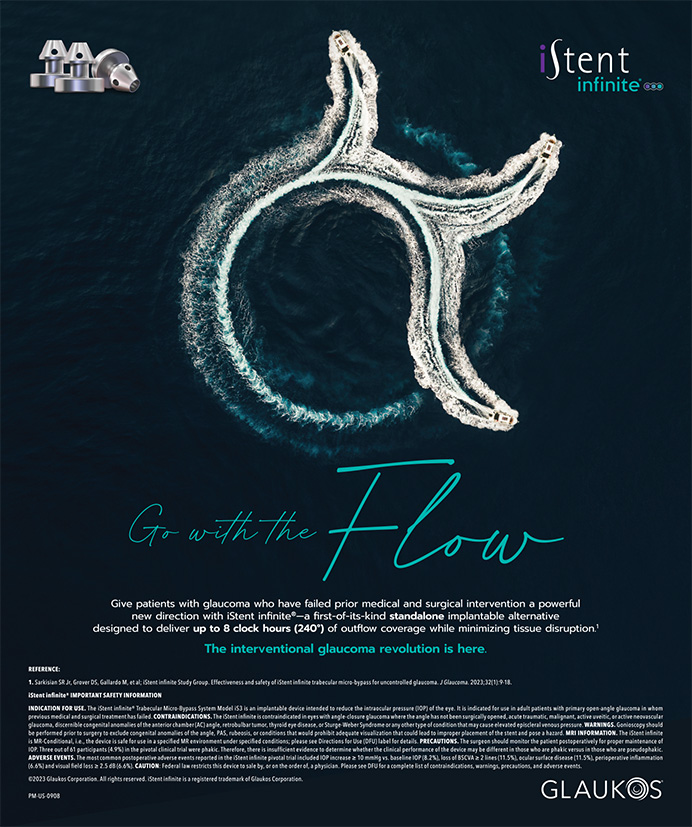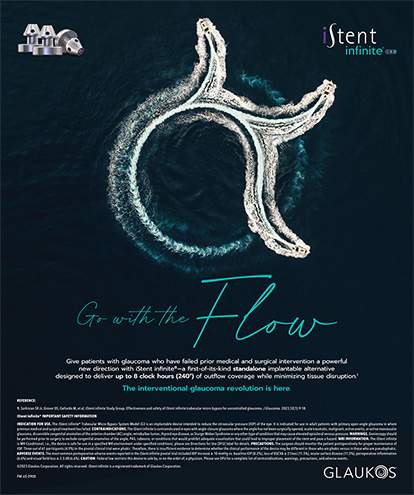CASE PRESENTATION
A 59-year-old white male presented for refractive surgical evaluation. His preoperative refractive error was 1.00 D OD and 1.25 D OS. His central corneal pachymetry measured 526 µm OD and 525 µm OS by ultrasound, and his keratometry readings were 43.7/44.3 X82 D OD and 43.7/44.3 x 89 D OS (Figure 1A).
After a thorough discussion of informed consent, the patient elected to undergo monovision treatment in his left eye, expressing a preference for surface ablation over LASIK. The surgeon performed Epi-LASIK using the Amadeus II microkeratome (Advanced Medical Optics, Inc., Santa Ana, CA) on the patient's right eye without any complications.
Next, the surgeon performed Epi-LASIK in the patient's left eye in a similar fashion. After the epithelial flap's formation, inspection of the corneal surface revealed smooth Bowman's membrane in the peripheral cornea. Centrally, however, there was an elliptical-shaped divot measuring approximately 5 mm long by 3 mm wide, which represented a stromal incursion.
The surgeon performed a modified monovision ablation of 2.00 D on the patient's left eye. Because the ablation was peripheral, it was not expected to interfere with the stromal divot. The cornea was treated with mitomycin C (MMC; 0.2 for 12 seconds) and thoroughly irrigated with 15 mL of balanced salt solution. The epithelial flap was discarded, and the stromal divot was not replaced.
Three months postoperatively, the patient's refraction was still fluctuating at approximately 0.50 2.50 X40. Although his refraction was correctable to 20/20, his vision was not crisp (Figure 1B).
How would you prevent (if possible) the formation of a stromal incursion during Epi-LASIK? How would you re-treat this patient to improve his subjective complaints and UCVA? Could LASIK bypass the area of superficial irregularity, or would PRK be a better choice?
WILLIAM B. TRATTLER, MD
Two main benefits of Epi-LASIK compared with other surface ablation techniques are somewhat less pain and have the potential for slightly quicker epithelial healing. We can choose from many different FDA-approved epikeratomes, each of which uses different strategies to separate the corneal epithelium from the underlying stroma. Regardless of the technology, however, virtually all of these devices carry the risk of a stromal incursion. The Gebauer EpiVision System (Gebauer Medizintechnik GmbH, Neuhausen, Germany), which is designed with a leading applanation plate that helps prevent the epikeratome from diving into the stroma, appears to be associated with a lower risk of a stromal incursion.
Surgeons using an epikeratome must understand the signs of a stromal incursion and be able to manage the complication when it occurs. Although it is not possible to avoid stromal incursions with Epi-LASIK, patient selection can help reduce the risk. In particular, surgeons should exclude patients with anterior stromal scars, epithelial basement membrane disease, a history of foreign body removal, or recurrent erosions, because they may have irregularities in their Bowman's membranes that can serve as an entry point for the epikeratome to create a stromal divot. Previous RK, surface ablation, or excision of a pterygium can also create superficial irregularities or adhesions at the level of Bowman's membrane that can lead to an increased risk of a stromal incursion. Obviously, Epi-LASIK should not be performed in patients who have already undergone LASIK, as there is a high risk of flap dislocations during the epikeratome's pass.
In the case described herein, the surgeon recognized that a stromal incursion had occurred. The proper management of this complication involves sliding the stromal divot back into position. In my experience, replacing stromal divots is very simple and ensures that the cornea's normal contour is preserved. Unfortunately, this step was not performed. By not replacing the divot, the surgeon left a shallow crater in the central cornea that has resulted in irregular corneal astigmatism (Figure 1B). Fortunately, the surgeon used MMC intraoperatively, which is important for reducing the risk of postoperative haze in complicated surface ablation procedures.
The rehabilitation of this patient's cornea is a major challenge due to the severity of his irregular astigmatism. First, it is important to wait for the refraction to stabilize. Once stability is achieved, the goal of re-treatment is to smooth out the corneal irregularity with phototherapeutic keratectomy (PTK) without inducing a significant hyperopic shift. Intraoperative MMC 0.02 should be applied for 30 to 60 seconds at the conclusion of PTK to avoid the formation of anterior stromal haze. Note that the cumulative exposure to MMC with the initial Epi-LASIK and the PTK procedure would still only be 75 seconds, which is shorter than the standard 2-minute protocol recommended just a few years ago.
After the PTK procedure, the patient will need to wait another 3 to 6 months before he achieves refractive stability. Once his refraction has stabilized, a final wavefront-guided surface ablation procedure will typically help bring the post-PTK cornea back toward plano. When planning the final wavefront surface ablation procedure, it is important to check the corneal pachymetric measurement before treatment to confirm that the residual stromal bed will be left with adequate thickness. Overall, the patient should achieve a reasonable result. The simple step of replacing the stromal divot and either aborting the laser procedure or treating over the top of the stromal divot, however, could have easily allowed for a very satisfactory visual outcome.
THOMAS CLARINGBOLD II, DO
The easiest way to prevent the type of stromal incursion described here is to perform a standard, non-keratome–based surface procedure such as LASEK or PRK. If the surgeon strongly wanted to perform Epi-LASIK to avoid the potential toxicity of alcohol in LASEK or avoid the mechanical debridement of the epithelium in PRK, his choice of microkeratome could make a difference. I feel the problem of stromal incursion is due to a variable angle of incidence as the separator meets the cornea (due to variable keratometry readings, proper suction, ring size, etc.). Epikeratomes with applanation bars, such as the Gebauer EpiVision system (Gebauer Medizintechnik GmbH), decrease the risk of incursions by creating a consistent angle of incidence regardless of patient variables. If an incursion occurs, I strongly recommended not proceeding with the ablation. Replace the flap (hopefully with the strip of stroma replaced as well), place a bandage contact lens over the flap, and allow it to heal and topographically stabilize.
To treat the patient's postoperative irregular astigmatism, I would not perform a stromal flap surgery such as LASIK. I would continue to monitor this patient for another 3 months, because he is still experiencing fluctuations. If his refraction and topography were stable at the end of the observation period, I would consider performing conventional (not wavefront) LASEK. Using a 9-mm well, I would apply the alcohol solution to the cornea for 45 to 50 seconds to facilitate creating the epithelial flap without disturbing any healing that may have occurred at the site of the incursion. Due to the patient's age, I would also consider performing a refractive lens exchange with monovision or a multifocal IOL in lieu of additional laser-based treatment.
RONALD R. KRUEGER, MD, MSE
Performing surface ablation such as PRK could prevent the type of stromal incursion created in the patient's eye. The potential benefit of EpiLASIK in reducing the discomfort and healing time in surface ablation has not been conclusively demonstrated; in fact, many surgeons are tearing off the epithelial flap in order to encourage the new growth of the epithelium. In many ways, this step makes Epi-LASIK behave in a similar manner to transepithelial PRK or another minimal-touch PRK.
If I did create a stromal incursion during surface ablation, however, I would not treat the patient with the laser but rather would realign the epithelial flap and its attached stromal incursion on the cornea and cover it with a bandage contact lens. Realignment of the stromal incursion may not be difficult if the epithelial flap is still attached at the hinge. Once realigned, the stromal incursion would need to heal, which would require several postoperative months.
If after several months, the patient's refraction was stable, I would plan a transepithelial PTK (to remove epithelium from the central cornea) and scrape the peripheral epithelium for the transition zone. I would then perform hyperopic PRK with MMC (0.02 for 30 seconds). Although some surgeons might consider topography-guided PRK where available, I would avoid this method, as well as wavefront-guided PRK, because of the anterior stromal smoothing due to transepithelial ablation, which may minimize a great deal of aberrations from incursion irregularity without using custom PRK. I recommend performing conventional PRK to minimize the depth to which tissue is removed and to better target emmetropia. I would not perform LASIK.
Because this patient is both hyperopic and older in age, I would not initially perform hyperopic EpiLASIK or surface ablation, as it is not approved in the US. Rather, as an alternative procedure, I may consider hyperopic IntraLASIK (Advanced Medical Optics, Inc.) with monovision or refractive lens exchange with either multifocal IOLs or monofocal IOLs targeting monovision correction.
Section editor Karl G. Stonecipher, MD, is Director of Refractive Surgery at TLC in Greensboro, North Carolina. Parag A. Majmudar, MD, is Associate Professor, Cornea Service, Rush University Medical Center, Chicago Cornea Consultants, Ltd. Stephen Coleman, MD, is Director of Coleman Vision in Albuquerque, New Mexico. They may be reached at (847) 882-5900; pamajmudar@chicagocornea.com.
William B. Trattler, MD, is a corneal specialist at the Center for Excellence in Eye Care in Miami and a volunteer assistant professor of ophthalmology at the Bascom Palmer Eye Institute in Miami. He acknowledged no financial interest in the products or companies mentioned herein. Dr. Trattler may be reached at (305) 598-2020; wtrattler@earthlink.net.
Thomas Claringbold II, DO, is Chief Ophthalmologist for MidMichigan Physicians Group in Clare, Michigan, and Assistant Clinical Professor at Michigan State University in East Lansing, Michigan. He acknowledged no financial interest in the products or companies mentioned herein. Dr. Claringbold may be reached at (989) 802-88f; eyeboy@tm.net.
Ronald R. Krueger, MD, MSE, is Medical Director of the Department of Refractive Surgery, Cole Eye Institute, Cleveland Clinic Foundation, in Cleveland. He acknowledged no financial interest in the products or companies mentioned herein. Dr. Krueger may be reached at (216) 444-8158; krueger@ccf.org.


